【National treasure】
Arm Guards with Ornaments of Chrysanthemums, Flowing Water, and Butterflies

These arm guards were created during the thirteenth century. As the only complete pair to survive from Japan’s medieval period (1185–1568), they are designated a National Treasure.
The distinguishing feature of this piece of armor is its intricate gold-plated ornamentation. The carvings on the tops of the handguards show butterflies spreading their wings against backgrounds of chrysanthemums and flowing water. This auspicious imagery symbolizes long life. Each tiny section of the butterflies’ wings is decorated with a different motif, including birds, ivy, and oak leaves.
The earliest use of arm guards can be seen in clay haniwa figures from the Kofun period (ca. 250–ca. late 700s). Many of these early examples only covered the forearms. Once mounted archery came to dominate the battlefield in the ninth century, warriors began wearing full-sleeve guards only on their left arms to keep their right arms unencumbered for drawing and firing a bow. The use of full-sleeve guards on both arms began in the mid-1300s, when close-quarters combat with swords became more common. This matching pair from the 1200s is a particularly early example.

この英語解説文は観光庁の地域観光資源の多言語解説整備支援事業で作成しました。
